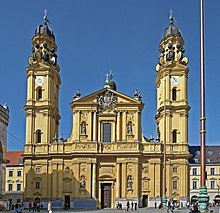
Back Ilesia d'os Teatinos de Múnich AN Teatin kilsəsi Azerbaijani Theatinakirch (Minga) BAR Тэатынеркірхэ Byelorussian Театинска църква (Мюнхен) Bulgarian থিয়েটিন গির্জা Bengali/Bangla Theatinerkirche (München) German Theatinerkirche (Múnich) Spanish Theatinerkirche Finnish Église des Théatins French
| Theatine Church | |
|---|---|
German: Theatinerkirche St. Kajetan | |
 | |
| 48°08′31″N 11°34′35″E / 48.14194°N 11.57639°E | |
| Location | Salvatorplatz 2a Munich, Bavaria |
| Country | Germany |
| Denomination | Roman Catholic |
| Website | www |
| History | |
| Status | Parish church |
| Dedication | Saint Cajetan |
| Architecture | |
| Functional status | Active |
| Style | Baroque |
| Years built | 1663–1688 1676–1690 (towers) 1765–1768 (façade) |
| Specifications | |
| Capacity | 400[1] |
| Width | 15.5 metres (51 ft)[1] |
| Number of domes | 1 |
| Dome diameter (outer) | 17.7 metres (58 ft) |
| Number of towers | 2 |
| Tower height | 64.6 metres (212 ft)[1] |
| Administration | |
| Archdiocese | Munich and Freising |
| Clergy | |
| Pastor(s) | P. Dr. Robert Mehlhart OP |
| Laity | |
| Director of music | Dr. Robert Mehlhart OP, since 2012 |
| Organist(s) | Riccardo Ricci (since 2023) |
The Theatine Church of St. Cajetan and Adelaide (German: Theatinerkirche St. Kajetan und Adelheid)[2] is a Catholic church in Munich, southern Germany. Built from 1663 to 1690, it was founded by Elector Ferdinand Maria and his wife, Henriette Adelaide of Savoy, as a gesture of thanks for the birth of the long-awaited heir to the Bavarian crown, Prince Max Emanuel, in 1662. Now administered by the Dominican Friars, it is also known as the Dominican Priory of St. Cajetan.
The church was built in Italian high-Baroque style, inspired by Sant'Andrea della Valle in Rome, designed by the Italian architect Agostino Barelli. His successor, Enrico Zuccalli, added two 66 meters high towers, originally not planned, and then finished the 71-metre-high (233 ft) dome in 1690. The church is 72 metres (236 ft) long and 15.5 metres (51 ft) wide. The facade in Rococo style was completed only in 1768 by François de Cuvilliés. Its Mediterranean appearance and yellow coloring became a well known symbol for the city and had much influence on Southern German Baroque architecture.
- ^ a b c "Kirche – Zur Einstimmung (Church – Introduction". theatinerkirche.de.
- ^ Bauer, Hermann; Bauer, Anna (1993). Klöster in Bayern: eine Kunst- und Kulturgeschichte der Klöster in Oberbayern, Niederbayern und der Oberpfalz (in German). C.H.Beck. p. 130. ISBN 978-3-406-37754-9. Retrieved 17 July 2022.

